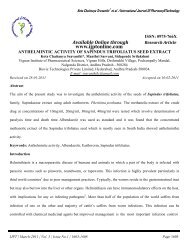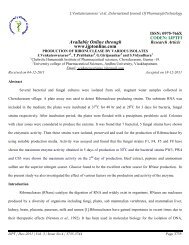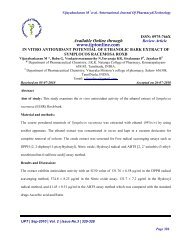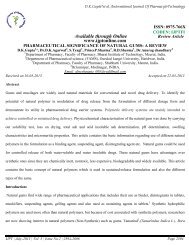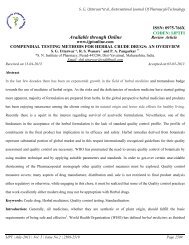ISSN: 0975-766X CODEN: IJPTFI Available through Online Review ...
ISSN: 0975-766X CODEN: IJPTFI Available through Online Review ...
ISSN: 0975-766X CODEN: IJPTFI Available through Online Review ...
- No tags were found...
You also want an ePaper? Increase the reach of your titles
YUMPU automatically turns print PDFs into web optimized ePapers that Google loves.
Vijay. K * et al. /International Journal Of Pharmacy&Technology4. METAL OXIDE SEMICONDUCTOR SENSORS:Metal oxide semiconductor (or MOS) sensors may be used for toxic as well as combustible gas monitoring.As discussed previously in the combustible gas monitoring section, MOS sensing elements consist of a metal oxidesemiconductor such as tin dioxide (SnO 2 ) on a sintered alumina ceramic bead contained within a flame arrestor. Inclean air the electrical conductivity is low, while contact with reducing gases such as carbon monoxide orcombustible gases increases conductivity. Sensitivity of the sensing element to a particular gas may be altered bychanging the temperature of the sensing element.Fig. 5. Metal oxide semiconductor sensorMOS sensors are "broad range" devices designed to respond to the widest possible range of toxic andcombustible gases, including chlorinated solvent vapors and other contaminants difficult to detect by other means.This non specificity can be advantageous in situations where unknown toxic gases may be present and a simple go orno go determination of the presence of toxic contaminants is sufficient. Since sensitivity of the sensing element to aparticular gas is mathematically predictable, a commonly used strategy is to preprogram the instrument with anumber of theoretical specific response curves. If the exact nature of the contaminant is known, an identification codecan be entered, and readings of the sensor will be adjusted to reflect the expected sensitivity of the sensor to thecontaminant being measured. MOS sensors offer the ability to detect low (0 - 100 ppm) concentrations of toxic gasesover a wide temperature range. The chief limitations concerning use of this kind of sensor are the difficulty in theinterpretation of positive readings, the potential for false positive alarms, and the effects of humidity on sensor output.IJPT | Dec-2011 | Vol. 3 | Issue No.4 | 1709-1723 Page 1718



